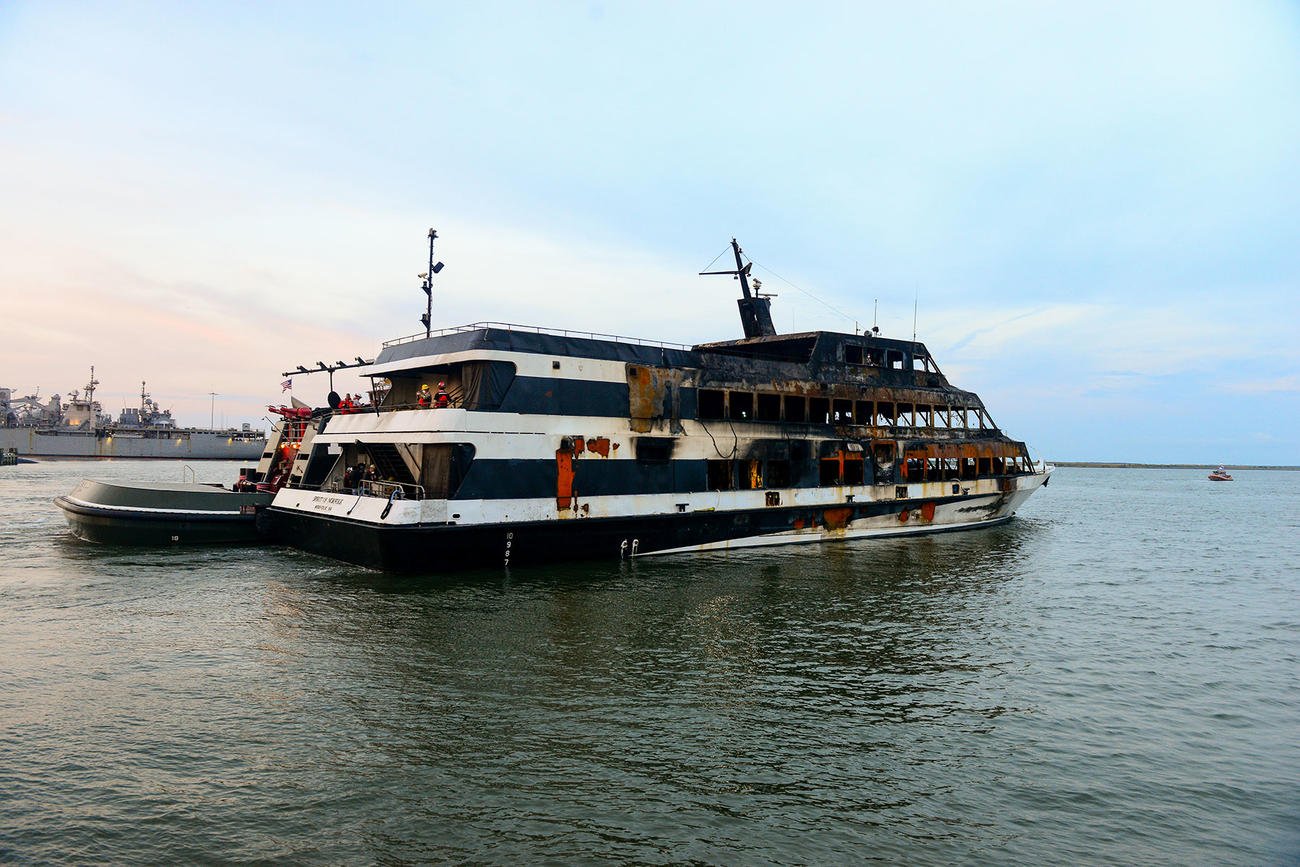
The fire that decimated the Spirit of Norfolk last year originated from the port side engine of the ship and was fueled by combustible material near the engine, a fire investigator with the Bureau of Alcohol, Tobacco, Firearms and Explosives testified Tuesday.
The fire has been deemed accidental but no final conclusions about the cause have been made by any investigative agency, according to a report by ATF Special Agent Brian Vaughn.
Vaughn’s testimony comes amid a series of public hearings before a panel of United States Coast Guard and NTSB investigators.
The Spirit of Norfolk caught fire during a cruise down the Elizabeth River on June 7, 2022, while 108 people were on board, including elementary school students. No one was injured in the fire thanks to a rapid response, but the ship — valued at $4 million, according to Vaughn’s report — was a total loss.
Vaughn’s investigation was to determine criminal intent, and thus did not render an opinion on the specific technical failure that caused the fire. The National Transportation Safety Board will produce conclusions about the cause of the fire independent of the Coast Guard, as well as make recommendations to correct any safety issues they uncover.
Vaughn concluded the fire was fueled by combustible material — including cardboard boxes — stored on shelving close to the engine. A split in the starboard fuel tank, caused by excess heat, resulted in diesel fuel leaking into the engine room and the spread of the fire throughout the majority of the ship.
“I investigate every fire from a criminal standpoint; do I see a crime here? Did someone intentionally do something, did someone do something that they shouldn’t have been doing in that engine room at the time that this fire originated? I think the answer to that is clearly no,” Vaughn said. “The fire patterns I see come back to that port side engine, some failure on, near or about that engine causing the event. So we call it accidental.”
The causes he ruled out were the hydraulic system, the electric generators and the starboard engine. The hydraulics suffered a mechanical failure as a result of the fire, he said. The generators were in working order and the crew reported the ship only lost power after their system alerted them to the port side engine failure. The starboard engine failed when Capt. Ryan Nadeau tried to reengage the port side engine, according to Vaughn’s report.
The equipment in the wheelhouse, or the “cockpit” of the ship, used to monitor the ship’s systems was badly damaged in the fire, and no data could be recovered.
A major focus of Vaughn’s report was the state of the turbocharger on the port side engine.
The boat had passed inspection May 10, but experienced several technical malfunctions between then and the day of the fire. On May 13, the ship suffered a failure in the water pump housing, causing the port engine to overheat, according to Vaughn’s interviews with the crew. Bay Diesel found a hole in the port engine which had leaked anti-freeze and resulted in overheating.
Bay Diesel conducted repairs and the ship was cleared to resume operations, but white smoke was seen coming from the engine before its first cruise.
Bay Diesel found anti-freeze had mixed with the engine oil to cause this issue, and recommended a complete rebuild of the port engine which was finished by May 26, according to Vaughn’s report.
The ship completed 18 cruises between May 26 and the fire on June 7 with no issues from the engine, but at some point the crew noticed oil leaking from the port turbocharger. Bay Diesel and Nadeau recommended the turbocharger be replaced. A new one was ordered, but it had not been replaced by the time of the fire on June 7.
Bay Diesel also recommended the other turbocharger be replaced as a precaution.
Based on his own research, Vaughn said that a failing turbocharger could produce temperatures above 1,800 degrees. He noted the issue with the turbocharger because it seemed important but did not make a determination about whether this was the cause of the fire.
“This temperature is capable of igniting combustible items stored in the area of the Port side engine,” Vaughn’s report reads.
©2023 The Virginian-Pilot. Visit pilotonline.com. Distributed by Tribune Content Agency, LLC.
Show Full Article
© Copyright 2023 The Virginian-Pilot. All rights reserved. This material may not be published, broadcast, rewritten or redistributed.
Tags: Aboard Agent ATF Coast Guard Coast Guard News Combustible Cruise Engine Fire Fueled Hearings Material Military Norfolk room Ship Spirit Testifies Working Warriors








